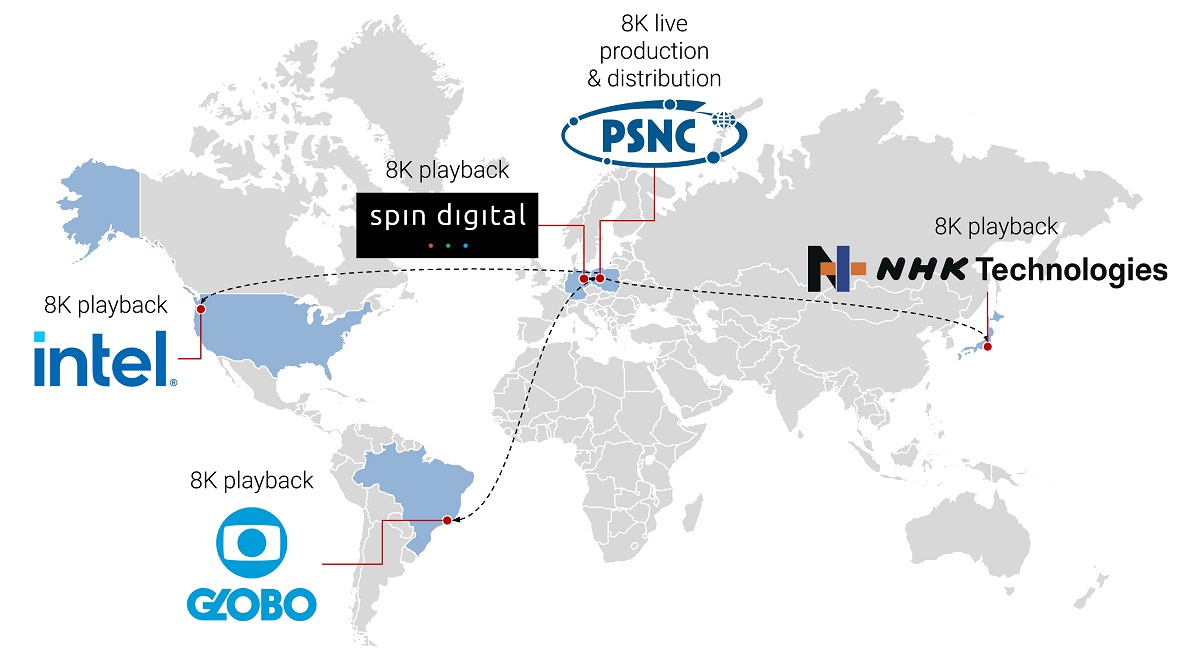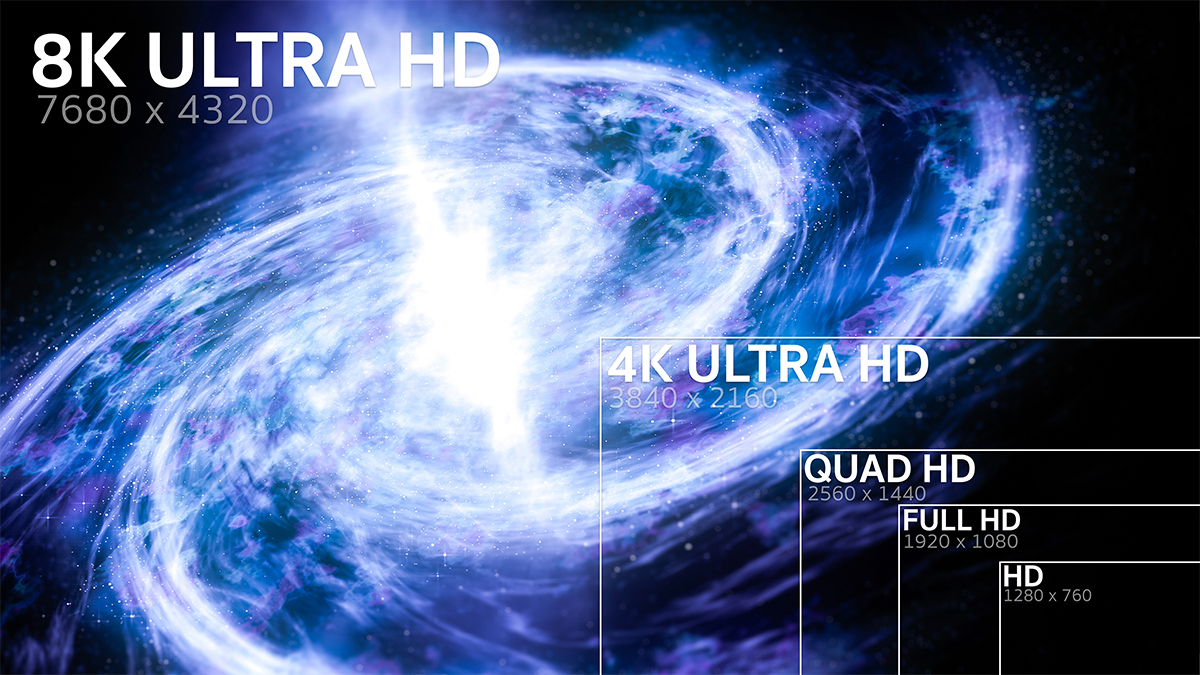A group of global leaders has presented a demonstration of 8K live streaming over the internet, providing a visible path towards 8K adoption for large scale live events. The demonstration was presented on December 9, 2020 at multiple locations worldwide, organized by Intel (US), NHK Technologies (Japan), Poznan Supercomputing and Networking Center – PSNC (Poland), Spin Digital (Germany), Globo (Brazil), and with the support of Sony (Japan/UK), Astrodesign (Japan), and Zixi (US).
“Transmitting broadcast-quality 8K content live over the internet requires highly efficient video coding as well as reliable streaming technologies,” said Dr. Mauricio Mesa, CEO, Spin Digital and Ravindra Velhal, Global Content Strategist, Intel Corporation. “This demo highlighted the possibilities of a state-of-the-art HEVC software encoder for reducing the bitrate needed for 8K live applications, as well as the possibility of delivering low-latency live 8K over the internet. This is the result of our multi-year joint R&D efforts and perseverance to deliver more, better and faster pixels while collaborating with the industry leaders worldwide.”
Key technologies used in the demonstration included:
- Software HEVC real-time encoder able to compress 8K 60 Hz video with broadcast-grade quality at low bitrate and with low-latency
- Low-latency live streaming over the internet
- 8K live production using three cameras
- 8K HEVC software decoder and playback on 8K TVs with HDMI 2.1 interface

Seeing is Believing: End-to-End 8K Live Streaming
The immersive demonstration consisted of an end-to-end 8K live video showcase from live production to encoding, streaming and playback on 8K TVs. An 8K live program was produced at the PSNC’s 8K studio in Poznan (Poland). The video signal was live encoded using Spin Digital’s HEVC encoder and streamed to multiple locations across the world, where it was received live and played on 8K screens. Viewing locations included NHK Technologies in Tokyo, Globo in Rio de Janeiro, Intel in Portland Oregon, and Spin Digital in Berlin.
The 8K content, with 7680×4320 pixels, 10-bit, at 60 frames/s, was encoded in real-time using the new HEVC software encoder. The encoder was able to provide broadcast-grade quality in a low-latency configuration at 120 Mbit/s, and the same level of quality was possible with a bit rate of 48 Mbit/s in a high-efficiency encoding configuration.

The new encoder is able to process 8Kp60 HEVC video in real time using a CPU-only solution. It has been extensively optimized for Intel Xeon Scalable processors in order to achieve an unparalleled level of performance, with optimizations including advanced decision algorithms, SIMD processing using Intel’s AVX-512 instructions plus built-in AI acceleration from Intel DL Boost technology, and scalable multithreading for systems that can include hundreds of CPU cores.
The 8K content was distributed to multiple viewing points across the globe using the open internet. The streaming module of the encoder produced simultaneously an HTTP live stream (HLS) for final distribution, and a low-latency stream that was distributed using RTP and Zixi point-to-point protocols for reliable delivery over the internet.
The 8K live stream was played back using a software HEVC decoder and 8K media player developed by Spin Digital and running on Intel Core i9 CPUs. The media player includes a flexible output module with support for different 8K interfaces including HDMI 2.0, HDMI 2.1, and 12G SDI.
“Transmitting broadcast-quality 8K content live over the internet requires highly efficient video coding as well as reliable streaming technologies. This demo highlighted the possibilities of a state-of-the-art HEVC software encoder for reducing the bitrate needed for 8K live applications, as well as the possibility of delivering low-latency live 8K over the internet. This is the result of our multi-year joint R&D efforts and perseverance to deliver more, better and faster pixels while collaborating with the industry leaders worldwide.”
— Dr. Mauricio Mesa, Spin Digital & Ravindra Velhal, Intel Corporation
The content was viewed at different locations on 8K screens from different manufacturers, among them Sony’s KD-75ZH8 8K HDR Full Array LED TV. The TV was connected to the player using an HDMI 2.1 interface via a professional SDI-to-HDMI converter developed by Astrodesign.
Combining the low-latency configuration of the encoder and the low-latency settings in the transport protocol, it was possible to transmit 8K live video streams with a glass-to-glass latency between 1 and 2 seconds.
“Over the past three decades, Intel has been a driving force of new media formats, content access and content delivery by partnering with industry leaders and standards bodies worldwide. 8K technologies are the next frontier for immersive media and sports broadcasting. We look forward to helping unleash the potential of this media format,” said Rick Echevarria, VP and GM Intel Olympics Program and Pandemic Response Technology Initiative at Intel Corporation.
“The 8K technology developed by NHK in Japan will be utilized in this distribution system, and I realized that the 8K technology will be used not only in entertainment, but also in a wide range of fields such as medical care and security worldwide. NHK Technologies will continue to share cutting-edge technology with its partners and contribute to the creation of a media society,” said Masaru Yoshida, Executive Director of NHK Technologies.
“The demonstration was a continuation of the Immersify project, in which together with Spin Digital we developed tools and applications for creating, encoding and streaming high-quality immersive and interactive media. Thanks to the use of three cameras, additional 8K video sources and graphics overlaid on the image, it was possible to present what 8K television can look like,” said Maciej Glowiak, Head of New Media Department of PSNC.
“Globo has been supporting 8K UHD format for a long time. We believe that research of full 8K production workflows and new delivery networks technologies will guide us through the future to offer the best experience of our premium contents,” said Paulo Henrique Castro, Mediatech Lab Director at Globo.


